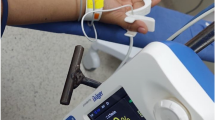Abstract
Purpose
We compared the reversal doses of sugammadex in surgical cases in which intraoperative neuromuscular monitor were used, to cases in which intraoperative neuromuscular monitoring was not used, retrospectively.
Methods
Data were collected by reviewing the electronic medical records of patients who received rocuronium and sugammadex during general anesthesia at Asahikawa Medical University Hospital between May 1, 2017 and April 30, 2018. The primary outcome was the reversal dose of sugammadex per patient actual body weight (mg/kg) between the group in which intraoperative neuromuscular monitoring was used (NM+ group) and the group in which intraoperative neuromuscular monitoring was not used (NM− group).
Results
A total of 3496 patients were evaluated, with 2544 patients (73%) included in NM+ group and 952 patients (27%) in NM− group. The reversal doses of sugammadex per actual body weight were significantly higher in NM− group compared to NM+ group. In the NM+ group, 521 patients (20%) received < 2 mg/kg sugammadex, 1377 patients (54%) received 2 ~ 2.5 mg/kg sugammadex, and 646 patients (25%) received > 2.5 mg/kg sugammadex. In contrast, 128 patients (13%) received < 2 mg/kg sugammadex, 362 patients (38%) received 2 ~ 2.5 mg/kg sugammadex and 462 patients (49%) received > 2.5 mg/kg sugammadex in NM− group.
Conclusion
This single-center retrospective study demonstrated that the use of intraoperative neuromuscular monitor reduced the reversal dose of sugammadex.


Similar content being viewed by others
References
Bom A, Hope F, Rutherford S, Thomson K. Preclinical pharmacology of sugammadex. J Crit Care. 2009;24:29–35.
Naguib M, Kopman AF, Lien CA, Hunter JM, Lopez A, Brull SJ. A survey of current management of neuromuscular block in the United States and Europe. Anesth Analg. 2010;111:110–9.
Grayling M, Sweeney BP. Recovery from neuromuscular blockade: a survey of practice. Anaesthesia. 2007;62:806–9.
Di Marco P, Della Rocca G, Iannuccelli F, Pompei L, Reale C, Pietropaoli P. Knowledge of residual curarization: an Italian survey. Acta Anaesthesiol Scand. 2010;54:307–12.
Fuchs-Buder T, Hofmockel R, Geldner G, Diefenbach C, Ulm K, Blobner M. The use of neuromuscular monitoring in Germany. Anaesthesist. 2003;52:522–6.
Domenech G, Kampel MA, Garcia Guzzo ME, Novas DS, Terrasa SA, Fornari GG. Usefulness of intra-operative neuromuscular blockade monitoring and reversal agents for postoperative residual neuromuscular blockade: a retrospective observational study. BMC Anesthesiol. 2019;19:143.
Milne JI, Ong CS, Ong JS, Cheung KC, Schauer AA, Buttar SB, Ledowski T. The influence of introducing unrestricted access to sugammadex and quantitative neuromuscular monitors on the incidence of residual neuromuscular block at a tertiary teaching hospital. An audit of ‘real-life’. Anaesth Intensive Care. 2016;44:784.
Kotake Y, Ochiai R, Suzuki T, Ogawa S, Takagi S, Ozaki M, Nakatsuka I, Takeda J. Reversal with sugammadex in the absence of monitoring did not preclude residual neuromuscular block. Anesth Analg. 2013;117:345–51.
Iwasaki H, Takahoko K, Otomo S, Sasakawa T, Kunisawa T, Iwasaki H. A temporary decrease in twitch response following reversal of rocuronium-induced neuromuscular block with a small dose of sugammadex in a pediatric patient. J Anesth. 2014;28:288–90.
Duvaldestin P, Kuizenga K, Saldien V, Claudius C, Servin F, Klein J, Debaene B, Heeringa M. A randomized, dose-response study of sugammadex given for the reversal of deep rocuronium- or vecuronium-induced neuromuscular blockade under sevoflurane anesthesia. Anesth Analg. 2010;110:74–82.
Eleveld DJ, Kuizenga K, Proost JH, Wierda JM. A temporary decrease in twitch response during reversal of rocuronium-induced muscle relaxation with a small dose of sugammadex. Anesth Analg. 2007;104:582–4.
Iwasaki H, Renew JR, Kunisawa T, Brull SJ. Preparing for the unexpected: special considerations and complications after sugammadex administration. BMC Anesthesiol. 2017;17:140.
Iwasaki H, Sasakawa T, Takahoko K, Takagi S, Nakatsuka H, Suzuki T, Iwasaki H. A case series of re-establishment of neuromuscular block with rocuronium after sugammadex reversal. J Anesth. 2016;30:534–7.
Takazawa T, Mitsuhata H, Mertes PM. Sugammadex and rocuronium-induced anaphylaxis. J Anesth. 2016;30:290–7.
Pongracz A, Szatmari S, Nemes R, Fulesdi B, Tassonyi E. Reversal of neuromuscular blockade with sugammadex at the reappearance of four twitches to train-of-four stimulation. Anesthesiology. 2013;119:36–42.
Batistaki C, Vagdatli K, Tsiotou A, Papaioannou A, Pandazi A, Matsota P. A multicenter survey on the use of neuromuscular blockade in Greece. Does the real-world clinical practice indicate the necessity of guidelines? J Anaesthesiol Clin Pharmacol. 2019;35:202–14.
Ledowski T, Ong JS, Flett T. Neuromuscular monitoring, muscle relaxant use, and reversal at a tertiary teaching hospital 2.5 years after introduction of sugammadex: changes in opinions and clinical practice. Anesthesiol Res Pract. 2015;2015:367937.
Acknowledgements
We express our thanks to Dr. Sorin J. Brull, Mayo Clinic, Jacksonville, Florida for the revision of the manuscript. We also thank Dr. Takahiro Suzuki, Nihon University, Tokyo, Japan for the revision and suggestions on statistical analysis. Part of the data in this article was presented at the nineth Annual Meeting of the Japanese Society of Anesthesiologists Hokkaido-Tohoku Region site (Sendai, 2019).
Author information
Authors and Affiliations
Corresponding author
Additional information
Publisher's Note
Springer Nature remains neutral with regard to jurisdictional claims in published maps and institutional affiliations.
About this article
Cite this article
Iwasaki, H., Kurosawa, A., Iida, T. et al. Use of intraoperative neuromuscular monitor reduces the reversal dose of sugammadex: a single-center retrospective study. J Anesth 34, 276–280 (2020). https://doi.org/10.1007/s00540-020-02739-1
Received:
Accepted:
Published:
Issue Date:
DOI: https://doi.org/10.1007/s00540-020-02739-1




